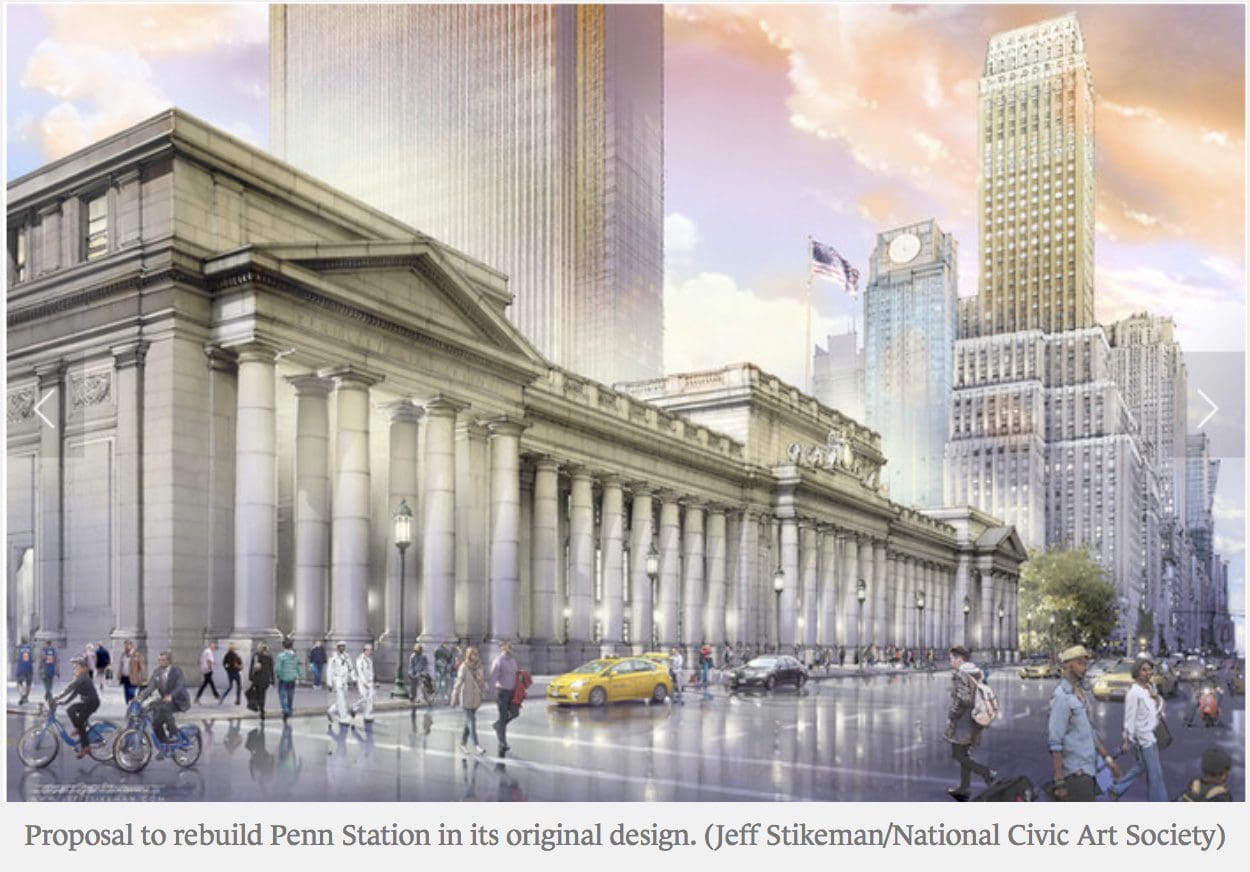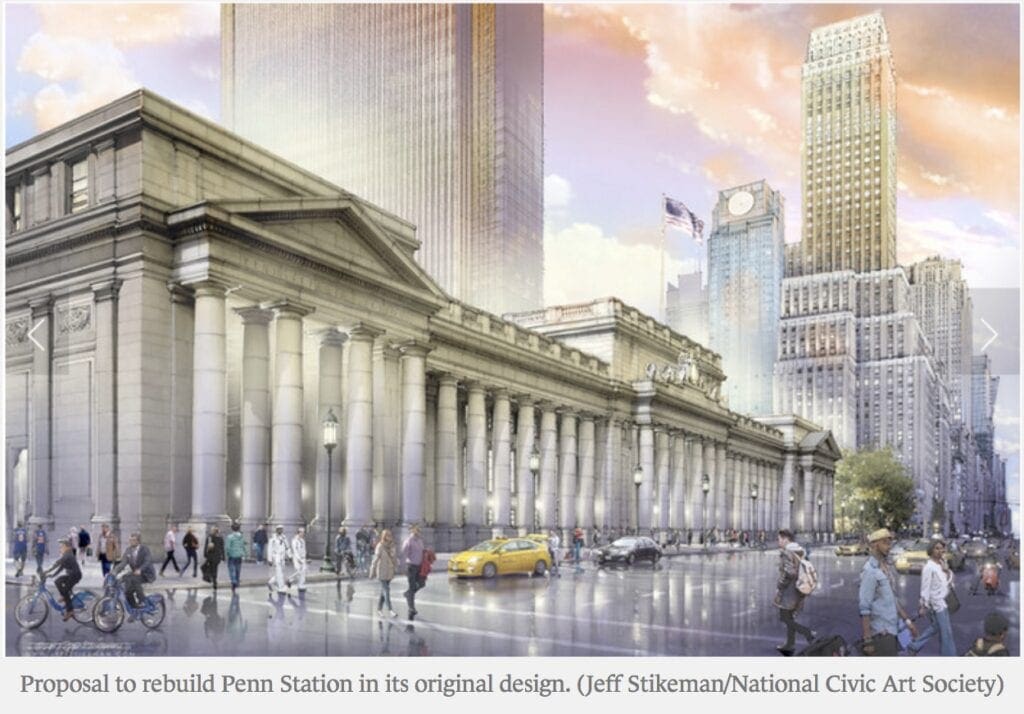Search Posts
Recent Posts
- Rhode Island Legislature Highlights Accomplishments for the 2025 Session June 25, 2025
- Sports in RI: Cody Tow, Volleyball Past, Present and Into His Future – John Cardullo June 25, 2025
- Need a Break? Time for Sour Grapes – Tim Jones June 25, 2025
- Rhode Island Weather Forecast for June 25, 2025 – Jack Donnelly June 25, 2025
- It is what it is: Commentary on 6.25.25 with Jen Brien June 25, 2025
Categories
Subscribe!
Thanks for subscribing! Please check your email for further instructions.

Executive Order: The Two Paths Ahead
By David Brussat, contributing writer, architecture
The draft executive order that is stirring within the Trump administration is forcing classicists in the field of architecture to choose one of two paths forward. The path that goes through the E.O., if it is not already throttled in its cradle, will give a boost to beauty in federal buildings, and open the way to challenge the dominant architectural culture. If this path is blocked, the status quo of modern architecture and its dominance in the field will continue for decades, possibly centuries.
Modernists, whose control of the establishment is threatened by the E.O., recognize the danger to their interests and are fighting it tooth and nail. Curiously, some classicists and traditionalists have taken up cudgels against their own liberation from modernism’s hegemony. They are undermining the unity needed to prevail on behalf of beauty.
Perhaps the most extreme example is the Institute of Classical Architecture & Art. The ICAA’s opposition was predictable, since the board that runs it from New York City sliced “advocacy” from its mission statement a year or so ago. No longer may chapters support or oppose relevant developments under the ICAA imprimatur, not even in their own regions. We are muzzled.
Why am I still in this organization, anyway? Why does it even exist?
The ICAA should don its thinking cap and consider the two alternative paths facing classical architecture.
The executive order, if signed by Trump, would represent an unexpected but powerful intervention in a hopeless situation – virtually a deus ex machina that offers traditional architecture a path to recapture its dominance in the field, which lasted many centuries until modern architects ousted tradition from the establishment after World War II for no good reason.
The chief architect of the General Services Administration recently resigned, and for the E.O. to be effective, the president must appoint a sympathetic replacement, and he, in turn, must replace or neutralize holdover GSA officials and managers who refuse to abide by the new dispensation. If that does not happen, the E.O. will be a dead letter.
If it does happen, the GSA will snap its fingers and battalions of fake Parthenons will begin marching down Washington’s broad avenues.
Only kidding.
If the E.O. is signed and classicists at the GSA are able to put it into practice, replacing the virtual mandate in favor of modern architecture in effect since 1962, federal courthouses, post offices, office buildings, monuments and other projects designed to please rather than to offend will begin to rise in the city of Pierre L’Enfant and in cities and towns around the country.
With each newly announced traditional project, in or out of Washington, modernist architecture critics will howl, and each time they do, the average member of the public will recognize how totally ridiculous are the modernist claims that classical architecture is “not of our time” or “copying the past” or “fascist.” They will judge the new buildings by their actual appearance. (As if the average person is stupid enough to believe that a building or its style is responsible for what takes place under its roof!)
Each building that rises up against the backdrop of this “discussion” will help to confirm the public’s natural preference for buildings that look like what they are supposed to be.
The executive order’s provisions would force federal officials to bring the public into the design process from which they’d previously been excluded. The modernist mandate from 1962, written by U.S. senator-to-be Daniel Patrick Moynihan, reads in part as follows:
Design must flow from the architectural profession to the Government, and not vice versa. … The advice of distinguished architects ought to, as a rule, be sought prior to the award of important design contracts.
Nothing in there about the public! During the decades since 1962, the built environment has been substantially degraded by modern architecture in and out of Washington. Modernists like to insist that the public is not interested in architecture. In fact, architecture is not interested in the public. Dismay at buildings that spurn conventional ideas of beauty, and the public’s exclusion from the process by which these junkyard dogs arise, has caused the public to tune out the built environment as a defense mechanism against the ennui of experiencing modern architecture – in part because individuals know that they can do nothing about it. That will change.
And once they are included in decisions regarding federal architecture they will expect to be included in local decisions about public architecture, and, at last, private architecture. This will force developers to pay more attention to public taste, and to facilitate the public’s involvement in the development process – because the public votes for the politicians who get money from developers and influence what and how they can build projects.
Once this process gets under way, the architecture profession and its firms will be forced to diversify their stylistic offerings to clients, private and public. That will force architecture schools to broaden their curricula to include classical coursework. It is not widely known that today there is only one [1] major architecture school that offers a classical curriculum: the University of Notre Dame. This will change.
Because classical architecture proudly uses ornament to embellish buildings, the changes described above will reform the largely monolithic character of the architectural profession. A revival will follow in jobs for artists, artisans and other makers creating decoration to replace the blank abstractions of modernism – a tepid sterility which fosters illness, anomie, and a tolerance among citizens for treatment as cogs in the machinery of society.
Because the public has a better (and more sophisticated) sense of taste than most design professionals marinated in modernism, public involvement in their cities’ development process will lead to more attractive buildings, and eventually to a greater affection for government buildings, and maybe, perhaps, respect for government itself.
The late Sir Roger Scruton wrote in The Classical Vernacular (1994) that the classically designed street “is humanly proportioned, safe, gregarious, and quietly vigilant, [and] constantly reminds the pedestrian that he is not alone, that he is in a world of human encounter, and that he must match the good manners of the [street] that guides him.”
The producer of the Star Wars films, George Lucas, reflected at least a subconscious recognition of this phenomenon when he created traditional habitats for his good guys and modernist habitats (such as the Death Star) for his evil characters. So maybe, in the end, classical architecture will help America avoid the authoritarian future predicted by so many elite thinkers. (I ended my last post on this subject, “Parsing classical creativity,” with the hope that classicism could prevent authoritarianism, and then a joke: “But don’t tell that to President Trump!”)
To top off this litany of almost certain results from adopting “Making Federal Buildings Beautiful Again” as U.S. policy – no more a “top-down mandate” than its predecessor – it would make America beautiful again.
Okay. So what if classicists refuse to unify behind the proposed E.O. and it dies for lack of support even among a large swath of classicism’s advocates?
The status quo would prevail, certainly for decades, possibly for centuries. Today, classicists mainly seek to advance by placing more classical classes – not coursework, let alone curricula – in more modernist architecture schools. Recently, classicists breathed a huge sigh of relief that Notre Dame hired a traditional architect/urbanist, Stefanos Polyzoides, as dean of its school of architecture. It became classicist only a few decades ago after a palace coup at the school, and that could be reversed, theoretically, at any time, even though Notre Dame’s is the only program whose graduates can count on getting a job in architecture right after graduation. Meanwhile, Catholic University, in D.C., is looking for a new dean of architecture amid some doubt, apparently, that a classicist will be hired or that the new slate of classical coursework at the school will even survive. Not too long ago, the Boston Architecture College addressed funding issues by simply ousting its minimalist classical program, and even refused to let the ICAA exhibit in its lobby. If the E.O. goes down, more of this is what classicists can expect.
If the E.O. dies, so will hope that classicism can expand upon the slow but steady growth it has seen over the past two or three decades. Today, the classical revival is based mainly on rich people who, like most people, tend to prefer classical or traditional styles over modernist styles. Whether they hire quality designers or otherwise, they hire classical architects to build their mansions. The wealthy have been the source of most classical commissions for decades, but the public doesn’t get to see the work. The ongoing debate between classicism and modernism (which modernists absurdly claim is over) may be said to have begun with ICAA founder Henry Hope Reed’s 1959 book The Golden City, and was given a boost, at least in Britain, by Prince Charles’s 1984 attack on the carbuncles of modernism. By killing off the E.O., modern architecture will retain the whip hand. New traditional architecture that the public can see, such as civic buildings, will remain rare. Such new buildings are important. They teach the public that traditional architecture is not lost to the past but is an equally valid vision of the future.
I’ve placed considerable stock in the recent proposal to rebuild Penn Station using the 1910 design of Charles Follen McKim. It would feature the sort of mechanical upgrading that has been a tradition of architecture for centuries. This is a tradition that most modernists pretend not to be aware of, as if new Georgian houses need to be fitted, still, with lightning rods on the roof and outhouses in the back yard. Anyway, the Penn Station plan, which is already a long shot under the current modernist regime, seems the most obvious prospect for erecting a major traditional building that millions of citizens will see, offering the possibility of a classical revival reminiscent of the City Beautiful movement sparked by the 1893 World’s Columbian Exposition, in Chicago. The new World Trade Center at Ground Zero in Lower Manhattan might have had a classically designed rebuild – a traditional proposal was offered by the firm of Franck Lohsen McCrery – but the rules called for “architecture of its time.” Yale just erected two beautiful new residential campuses in the Collegiate Gothic style (designed by Robert A.M. Stern’s robust firm), but how many non-Yalies travel to New Haven to see it?
So, short of some other kind of deus ex machina, what sort of possibilities will arise over the next decades to stoke the dreams of Americans who want their country to be beautiful again? Hope springs eternal, but the options are few and very difficult to imagine. Yes, the federal government is working to extend a set of rail platforms from Penn Station into the old historic post office next door (emblazoned with the motto “Neither snow nor rain … “). It was also designed by McKim, Mead & White, and is now known as Moynihan Train Hall after the creator of the modernist mandate under which America has groaned since 1962. As senator, Moynihan often went to bat for Amtrak funding. The station that bears his name is lovely, but it is certainly not new classicism, not the role model needed to give the classical revival a boost.
If the Trump administration were to back the plan for a MM&W rebuild of Penn Station, would leading classicists oppose it because of its connection to Trump? I hope not. And if not, then why do so many of classicism’s leading lights oppose the E.O.? There is no plausible reason.
Speaking of Daniel Patrick Moynihan, what did he think of his handiwork in writing the 1962 GSA principles mandating ugly federal buildings? Here’s what he had to say in 1970, just eight years later:
Twentieth-century America has seen a steady, persistent decline in the visual and emotional power of its public buildings, and this has been accompanied by a not less persistent decline in the authority of the public order.
Precisely.


My freelance writing and editing on architecture and others addresses issues of design and culture locally and globally. I am a member of the board of the New England chapter of the Institute of Classical Architecture & Art, which bestowed an Arthur Ross Award on me in 2002. I work from Providence, R.I., where I live with my wife Victoria, my son Billy and our cat Gato. If you would like to employ my writing and editing to improve your work, please email me at my consultancy, dbrussat@gmail.com, or call (401) 351-0457 https://architecturehereandthere.com/
